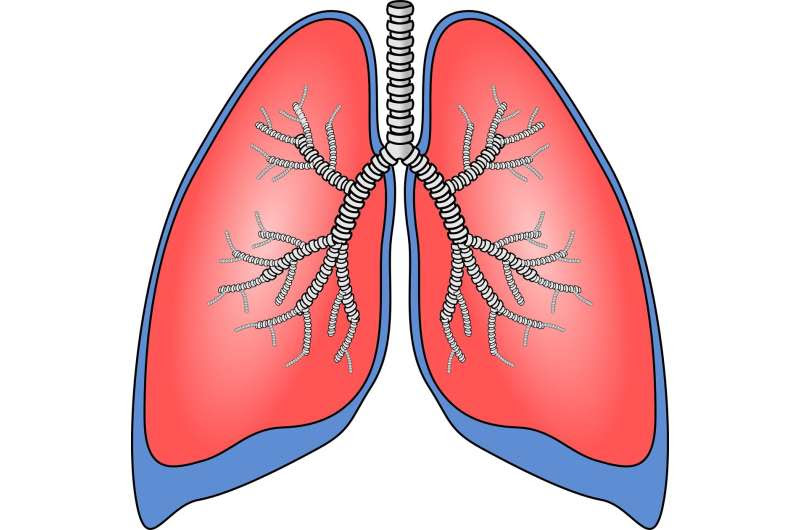by International Association for the Study of Lung Cancer

Credit: Pixabay/CC0 Public Domain
Adopting a lung nodule program (LNP) may increase the detection of early lung cancer for patients who are not eligible for lung cancer screening under existing age eligibility criteria, according to a study published in the Journal of Thoracic Oncology.
LNPs are established to follow up on lung nodules that are frequently identified during routine imaging for reasons other than suspected lung cancer or lung cancer screening.
The research was conducted by a team led by Dr. Raymond U. Osarogiagbon, MBBS, FACP, chief scientist for Baptist Memorial Health Care and director of the multidisciplinary thoracic oncology program and the thoracic oncology research group for Baptist Cancer Center, Memphis, Tennessee, U.S.
The prospective observational study compared the two-year cumulative lung cancer diagnosis risk, lung cancer characteristics, and overall survival (OS) among participants undergoing low-dose CT (LDCT) screening aged 50–80 years, and LNP participants aged 35 to 50 years and over 80 years of age.
The United States Preventive Services Task Force recommends annual screening for lung cancer with low-dose computed tomography (LDCT) in adults aged 50 to 80 years who have a 20 pack-year smoking history and currently smoke or have quit within the past 15 years.
Low-dose computed tomographic (LDCT) screening for lung cancer has been shown to reduce mortality by up to 20%. However, even after lowering the age of eligibility from 55 to 50 years, most persons diagnosed with lung cancer in the US are ineligible for lung cancer screening. LNPs, which typically use Fleischner Society lung nodule management guidelines, expand access to early lung cancer detection to a more diverse population.
Persons aged 50 to 80 years enrolled in a LNP were at greater risk of lung cancer diagnosis within two years compared to an LDCT cohort. The demographic, socio-economic characteristics, and risk factor profile of patients diagnosed with lung cancer through the LNP differed strikingly from that of the screened cohort.
The lung cancer risk in persons too young or too old for screening, but who have an incidentally detected lung lesion, had not previously been rigorously estimated. According to Dr. Osarogiagbon, the study compared the cumulative lung cancer diagnosis risk, lesion characteristics, lung cancer characteristics, treatment and outcomes of screening age-ineligible persons in a LNP to an LDCT screening cohort.
The study period spanning from 2015 to 2022 revealed that lung cancer was diagnosed in 329 (3.43%) LDCT, 39 (1.07%) young, and 172 (6.87%) elderly LNP patients. Strikingly, the two-year cumulative incidence rates were 3.0% (95% CI: 2.6%–3.4%) for LDCT, 0.79% (CI: 0.54%–1.1%) for young LNP, and 6.5% (CI: 5.5%–7.6%) for elderly LNP.
Despite age differences, the lung cancer diagnosis risk was found to be similar between young LNP and Lung-RADS 1 (aHR 0.88 [CI: 0.50–1.56]) and 2 (aHR 1.0 [0.58–1.72]). In contrast, elderly LNP risk exceeded that of Lung-RADS 3 (aHR 2.34 [CI: 1.50–3.65]) but was less than 4 (aHR 0.28 [CI: 0.22–0.35]).
Moreover, the study revealed significant differences in stage at the time of cancer diagnosis, with 62.92% of LDCT cases diagnosed at stage I/II compared to 33.33% for young (p=0.0003) and 48.26% for elderly (p=0.0004) LNP cohorts. Notably, 16.72%, 41.03%, and 29.65% of LDCT, young, and elderly LNP cases respectively, were diagnosed at stage IV.
The five-year OS rates were 57% (CI: 48–67), 55% (CI: 39–79), and 24% (CI: 15–40) respectively, with statistically significant differences (Log-rank p<0.0001), persisting even after excluding persons with any prior history of cancer.
“Our findings indicate that our Lung Nodule Program modestly benefitted individuals deemed too young or too old for traditional screening,” said Dr. Osarogiagbon. “The observed differences in clinical characteristics and outcomes strongly suggest variations in the biological characteristics of lung cancer in these distinct patient cohorts.”
More information: Journal of Thoracic Oncology (2023).
Journal information: Journal of Thoracic Oncology
Provided by International Association for the Study of Lung Cancer

Leave a Reply